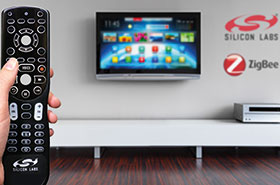

Silicon Labs has released a cost-effective solution for voice-enabled ZigBee remote controls. This comprehensive reference design solution significantly reduces the need for costly external hardware by implementing a high-quality, software-based audio codec into a single-chip wireless SoC. The new software codec is a key part of Silicon Labs’ form-factor reference design for voice-enabled, ZigBee-based and proprietary remote controls, bringing the power of voice to TVs, set-top boxes (STBs), over-the-top (OTT) boxes and connected home products.
As many ‘things’ for the IoT (Internet of Things) grow smarter and more connected, it becomes increasingly difficult to incorporate feature-rich user interfaces into small form factors. Voice enablement is transforming how we control and interface with connected devices by providing an easier, hands-free way to search, explore and experience content and services.
By combining the power of voice-over-RF technology and cloud-based speech recognition, voice-enabled remotes free consumers from the line-of-sight, pushbutton limitations of legacy infrared (IR)-based controls. Silicon Labs’ new voice codec technology and complete reference design simplify the process of designing truly smart remotes.
The ZigBee Remote Control (ZRC) reference design is based on Silicon Labs’ EM34x wireless SoCs and ZRC 2.0 Golden Unit-certified software stack, which provides an industry-standard way to implement interoperable, low-power RF remote controls. The reference design includes complete RF layout and design files, an acceleration sensor for backlight control, a buzzer for ‘find me’ capabilities, support for IR control, a digital microphone and the ability to transmit voice commands over RF.
Silicon Labs engineered the reference design to support voice control using either an external hardware codec or the company’s software codec technology. The hardware codec reduces the processing load on the EM34x SoC while the software codec trades off increased CPU utilisation for the lowest possible bill of materials (BOM) cost. Both design options meet the stringent voice quality requirements of leading cloud-based speech recognition software providers.
Two development kits are available for the voice-enabled reference design:
EM34X-VREVK Voice Remote Evaluation Kit – features pre-programmed devices and a simple GUI to demonstrate remote control capabilities including RF, voice commands and legacy IR support.
EM34X-VRDK Voice Remote Development Kit – providing an ‘out-of-the-box’ design experience, this full-featured kit simplifies development of the remote control and target devices and comes with an EM34x voice-enabled remote control, USB stick, EM34x development board, EM34x wireless modules and ISA3 debug adapter.
The EM34x wireless SoCs at the heart of the reference design handle all remote control functions. They combine a 2,4 GHz IEEE 802.15.4 transceiver with an ARM Cortex-M3 processor, Flash memory, RAM and peripherals. The transceiver’s efficient architecture delivers a link budget of 110 dB, providing a robust link for ZRC applications without an external power amplifier (PA) or low-noise amplifier (LNA). Integrated receive channel filtering and multi-level retries support co-existence with other 2,4 GHz standards such as Wi-Fi and Bluetooth.
Silicon Labs’ AppBuilder tool enables developers to configure remote control applications using a set of easy-to-use plug-ins that support key features such as keyboard drivers, LEDs, acceleration sensing and voice control. The company also offers a Desktop Network Analyser that, unlike traditional wireless sniffers, provides full visibility of all wireless networking activity by using the EM34x wireless SoC’s packet trace port.
For more information contact NuVision Electronics, +27 (0)11 608 0144, [email protected], www.nuvisionelec.co.za
| Tel: | +27 11 608 0144 |
| Email: | [email protected] |
| www: | www.nuvisionelec.com |
| Articles: | More information and articles about NuVision Electronics |

© Technews Publishing (Pty) Ltd | All Rights Reserved